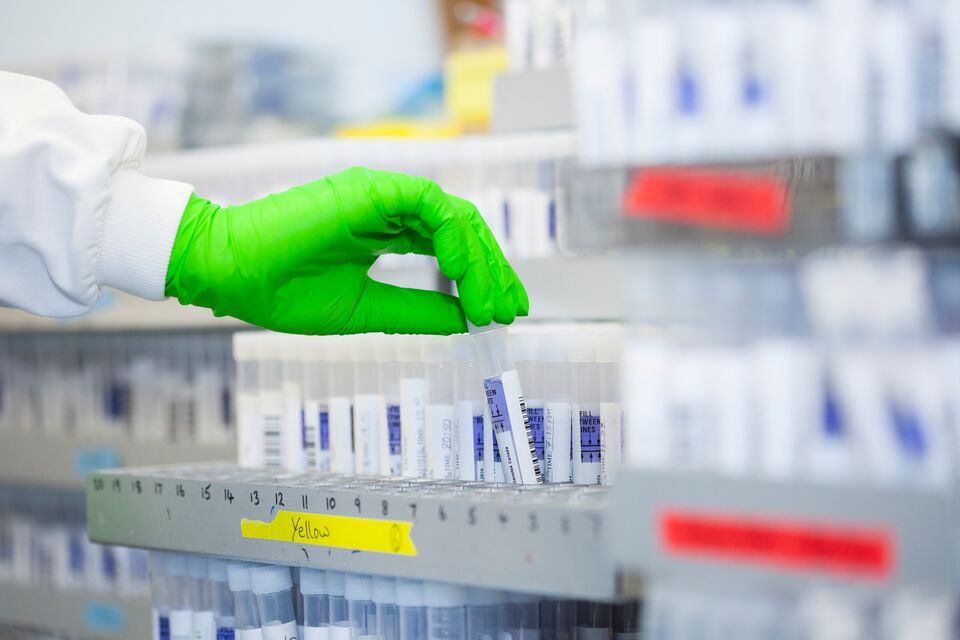
Our research into improving the transplant journey and developing new treatments is carried out across three sites in London and Nottingham.
The Anthony Nolan Research Institute
One of the greatest challenges in stem cell transplantation is understanding why some transplants are unsuccessful – even if the donor and patient seemed to be perfectly matched. In the early 90s it became clear that starting to overcome this challenge would require substantial investment in terms of both scientific resources and research expertise. Following years of intensive fundraising, the Anthony Nolan Research institute (ANRI) was opened in 1996 under the guidance of our former medical director Professor J Alejandro Madrigal.
To this day, ANRI strives to better understand what causes the problems that can occur post-transplant including graft vs host disease (GvHD), relapse and infections caused by viruses, as well as develop new therapies to treat and prevent them. It is home to our HLA Informatics and Immunotherapy research groups.
In 2020, ANRI was awarded Independent Research Organisation status by UK Research and Innovation. This means the institute can now apply directly to UK Research Councils for funding to increase our scientific research capacity even further.
The Anthony Nolan Cell Therapy Centre
Opened in 2008 by the UK Secretary of State for Health in the grounds of Nottingham Trent University, the Anthony Nolan Cell Therapy Centre is the first to combine a cord blood bank with a research facility that looks at new ways to use this valuable resource. The centre was established with the help of the James Tudor Foundation and the East Midlands Development Agency.
Anthony Nolan collects cord blood at hospitals in London, Leicester and Manchester. This blood is rich in potentially lifesaving stem cells that can be used in a transplant. Once collected, it’s taken to the Anthony Nolan Cell Therapy Centre where it is processed and stored for when it’s needed by stem cell transplant patients around the world.
Any collected cord blood that isn’t suitable for use in transplants doesn’t go to waste. The centre uses this blood to continually improve the banking, storage and quality control processes to make them as efficient as possible. The centre also provides cord blood cells to ethically approved academic and commercial research programmes throughout Europe with the aim of understanding disease and developing new lifesaving therapies.
The London Sequencing Labs
When a patient is in need of a stem cell transplant, our labs will sequence their HLA genes, along with those of potentially suitable donors in order to find the best possible match.
Our dedicated team of over 60 staff members and automated laboratory equipment process and sequence DNA samples every day. These vast amounts of data are then analysed by our bioinformatics team and the new donors are added to our register.
Our sequencing labs also offer various commercial sequencing services for scientific and medical research. This valuable source of funding is then used by Anthony Nolan to help save and improve the lives of more people with blood cancer and blood disorders.
Read more about the science behind how we match donors and patients.
Our history
From humble beginnings…
Our very first laboratory space, where two lab technicians tissue typed our very first donors, could not have been more different to the spacious and modern buildings used by our research staff today.
That first lab was little more than a large broom cupboard at Westminster Hospital in London, with basic equipment donated or borrowed from other departments. At this time, all donor tissue typing records had to be stored on index cards in a shoe box because commercial computers were still not available!
…to growing needs
As the register grew, so did the need to increase both the lab space and resources to type more and more donors. This led to the creation of the first ‘Anthony Nolan Laboratory’ at St Mary Abbot’s Hospital in 1976. However, it soon became clear that an even larger space would be needed.
So, in 1989, thanks mainly to the work of John Moxey, a farther of two who was being treated for leukaemia at the hospital at the time, the labs moved to the Royal Free Hospital in Hampstead. Initially work started in temporary porter cabins while a dedicated building was being constructed, but in 1990 the new laboratory space was opened and is still in use today.